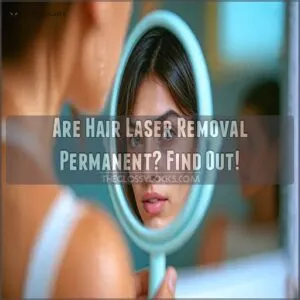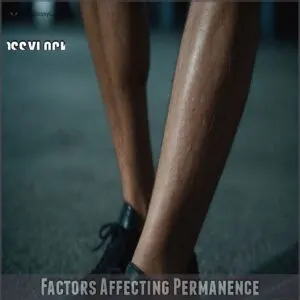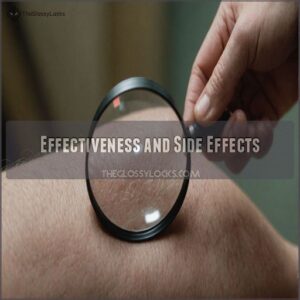This site is supported by our readers. We may earn a commission, at no cost to you, if you purchase through links.
 Are hair laser removal permanent? It’s a common question, and the short answer is: not quite. Think of it like this: you’re putting your hair follicles to sleep for a long time, not killing them off completely. Laser hair removal damages the hair follicle, greatly reducing hair growth for months, even years. You’ll likely see some regrowth, but it’ll be finer and lighter. It’s a great way to take control of unwanted hair, offering long-term freedom from shaving and waxing.
Are hair laser removal permanent? It’s a common question, and the short answer is: not quite. Think of it like this: you’re putting your hair follicles to sleep for a long time, not killing them off completely. Laser hair removal damages the hair follicle, greatly reducing hair growth for months, even years. You’ll likely see some regrowth, but it’ll be finer and lighter. It’s a great way to take control of unwanted hair, offering long-term freedom from shaving and waxing.
Want to know how to maximize your results and minimize regrowth? Read on to discover some surprising secrets…
Table Of Contents
- Key Takeaways
- How Laser Hair Removal Works
- Is Laser Hair Removal Permanent?
- Factors Affecting Hair Reduction
- Effectiveness and Side Effects
- Preparing for and Maintaining Results
- Frequently Asked Questions (FAQs)
- Can laser hair removal be permanent?
- Does laser hair removal really work?
- Are hair removal treatments permanent?
- How long does laser hair removal last?
- Does laser hair removal permanently reduce hair growth?
- What are the results of laser hair removal?
- How long does laser hair removal last?
- How long does laser hair removal permanent?
- Does hair grow back if you stop laser hair removal?
- Are there long-term effects of laser hair removal?
- How long does each treatment session take?
- Can I shave between laser treatments?
- What areas of the body can be treated?
- Is there an age requirement for laser hair removal?
- What should I do before a laser session?
- Conclusion
Key Takeaways
- Laser hair removal isn’t permanent, but it significantly reduces hair growth for a long time.
- You’ll likely see some regrowth, but it’ll be finer and lighter than before.
- Your skin tone and hair color, as well as the technician’s skill, affect the results.
- Maintenance treatments are needed to keep your skin smooth long-term.
How Laser Hair Removal Works
You might think of lasers as something out of a sci-fi movie, but they play a key role in hair removal by targeting hair pigment and heating follicles.
This process puts hair growth into dormancy and leaves you with smoother skin, although not forever, more like a snooze button than a permanent off switch!
Concentrated Light Technology
Imagine this: concentrated light technology in laser hair removal uses specific light wavelengths to target hair, similar to low-level laser therapy that stimulates hair growth and improves follicle health as seen in hair loss treatments such as laser caps.
The laser beams focus on the melanin in your hair, ensuring precise targeting while maintaining laser safety.
Whether you’re seeking permanent hair removal or just fewer hair removal sessions,
Heating Hair Follicles
Laser hair removal heats your hair follicles to put them in a deep freeze, so to speak.
By focusing on damaging the follicle, this treatment disrupts the hair growth cycle, reducing unwanted fuzz.
Think of it as convincing your hair it’s on an extended vacation.
Although it’s not exactly permanent, it makes regrowth lighter and less noticeable.
Targeting Hair Melanin
Picture yourself mastering hair removal with laser precision.
By targeting hair melanin, you halt unwanted growth efficiently.
The laser wavelengths zero in on darker hair colors, thanks to melanin concentration.
With each zap, hair follicles hit pause on growth.
But remember, a few treatments set the stage for smoother skin.
It’s like tuning in to your unique hair growth cycle dance!
Is Laser Hair Removal Permanent?
You might be wondering if laser hair removal is your ticket to never having to shave again.
While it reduces hair growth considerably, you’ll still need occasional maintenance sessions to keep those pesky hairs at bay.
Permanence of Results
Hair removal with laser technology isn’t a one-and-done affair.
You might wonder, "Is laser hair removal permanent?"
Well, it offers long-term results, but hair can regrow over time.
The trick is in how effectively the hair follicles are targeted and the number of treatment cycles completed.
Expect lighter and finer regrowth, asking yourself, "How long does laser hair removal last?"
It varies!
Factors Affecting Permanence
So, you’ve learned laser hair removal isn’t truly permanent.
But what affects how long your results last? Several things play a part. Let’s look at some key factors:
To achieve the best results, considering using products specifically designed for permanent hair removal solutions (permanent hair removal solutions).
- Your unique hair growth cycle.
- Your skin sensitivity.
- The **l
Maintenance Treatments
Wondering about the permanence of laser hair removal?
To keep smooth skin, maintenance treatments come into play.
Not a bad idea since they tackle any resilient hair follicles.
These touch-ups, typically yearly, help maintain the glow.
| Frequency | Cost | Benefits |
|---|---|---|
| Yearly | Varies | Long-lasting |
| Semi-annual | High | Reduced regrowth |
| As needed | Moderate | Fine-tuned reduction |
Factors Affecting Hair Reduction
To get the most out of laser hair removal, you’ll want to think about how skin tone, hair color, and the hair growth cycle come into play.
Don’t forget, the technician’s skill can make all the difference in achieving smooth results.
Skin Tone and Hair Color
Many folks wonder about the permanence of laser hair removal results.
What often makes or breaks the outcome is your skin tone and hair color.
Ideal candidates have lighter skin and darker hair due to melanin levels.
This combination optimizes the laser’s effectiveness.
It’s like sunlight seeking shadows—light hair doesn’t absorb lasers well, affecting permanent hair removal expectations.
Hair Growth Cycle
Switching from skin tone to the hair growth cycle, did you know it has three phases—Anagen, Catagen, and Telogen?
Each plays a part in your laser hair removal success.
You can learn more about these phases and their impact on treatment effectiveness on the website for laser hair removal phases.
During the Anagen phase, hair absorbs most laser energy, making treatments most effective.
Timing sessions with these phases enhances results and moves you closer to your permanent hair reduction goal.
Technician Skill Level
Understanding your hair growth cycle can set expectations, but don’t overlook the technician’s skill in shaping results.
A seasoned pro makes a big difference, especially when compared to natural hair removal methods like threading for hair reduction, which can also be effective in reducing hair growth over time.
- Laser experience guarantees precision and fewer mishaps.
- Training certification reflects solid technique mastery
Effectiveness and Side Effects
Exploring the effectiveness and side effects of laser hair removal, you’ll find that while the treatment greatly reduces hair growth, it’s not entirely permanent.
Common side effects like redness or skin irritation can occur, so don’t be surprised if your skin occasionally resembles a tomato.
Hair Reduction Rates
So, you’re wondering about results, right?
Hair reduction rates vary.
Let’s look at this:
| Session | % Reduction (Estimate) | Hair Regrowth | Typical Side Effects | Cost Per Session (Average) |
|---|---|---|---|---|
| 1 | 10-25% | Noticeable | Redness, slight swelling | $293 |
| 2 | 25-40% | Less dense | Minimal | $293 |
| 3 | 40-60% | Finer hairs | Rare | $293 |
| 4 | 60-75% | Sparse | None | $293 |
| 5+ | 75-90%+ | Minimal | None | $293 |
Individual differences matter.
Treatment duration and cost depend on your hair and skin.
Long-Term Hair Reduction
You’ve heard about hair reduction rates, but what’s the scoop on long-term hair reduction?
Laser hair removal isn’t permanent, but it offers lasting benefits, with the cost varying depending on Laser hair removal cost.
By targeting the hair growth cycle, unwanted hair grows back finer and lighter.
Opt for professional sessions over at-home alternatives for the best results.
They’re worth the laser hair
Common Side Effects
Experiencing permanent hair reduction sounds fantastic, but a little reality check is wise too.
Common side effects of your laser journey include skin irritation, redness, and a bit of swelling—like your skin’s little protest.
Occasionally, blistering or crusting might make an appearance.
While these laser hair removal permanent side effects are usually mild, consult a pro if symptoms persist.
Preparing for and Maintaining Results
To get the best results from laser hair removal, you’ll need to prep properly and follow some easy but important aftercare steps.
Think of it like watering a new plant—safe, consistent care leads to a flourishing outcome!
Pre-Treatment Guidelines
Before your laser hair removal appointment, think of it as prepping for a smooth journey. Follow these steps for effective results:
- Pre-treatment skin prep: Cleanse the area gently.
- Medications to avoid: Steer clear of aspirin.
- Sun exposure advice: Skip the sunbathing two weeks before.
- Hair length recommendations: Leave some stubble for the laser to target.
Aftercare Instructions
Smooth sailing begins after your laser hair removal session with some TLC.
Embrace gentle skin care and stay out of the sun to help those hair removal results look their best.
Hydration aids healing, while cooling methods soothe your skin.
Skip irritants like perfumes; your skin’s worn a brave face under the laser!
| Aftercare Step | Reminder |
|---|---|
| Skin Care | Use gentle, unscented products |
| Sun Exposure Avoidance | Wear SPF 30+ sunscreen |
| Cooling Methods | Apply aloe vera or cold packs |
Maintenance Treatment Schedule
Imagine laser hair removal treatments as a symphony for smooth skin.
To keep the concert going, follow a maintenance treatment schedule.
Typically, this means coming in once or twice a year.
It’s key for maintaining hair removal results and ensuring the effectiveness of each session.
The cost might vary, but the benefits of long-lasting smoothness are unbeatable.
Frequently Asked Questions (FAQs)
Can laser hair removal be permanent?
Laser hair removal isn’t fully permanent, but it greatly reduces unwanted hair.
While it temporarily halts hair growth, any regrown hair comes back finer and lighter, offering a long-term solution for smoother skin with fewer pesky follicles.
Does laser hair removal really work?
Yes, laser hair removal works by substantially reducing hair growth.
It heats and damages hair follicles, making regrowth slower and hair finer.
While not permanent, it offers long-lasting results, especially effective on darker hair and lighter skin.
Are hair removal treatments permanent?
Think of laser hair removal treatments as putting your hair growth on pause rather than deleting it.
They aren’t permanent, but they slow growth and reduce hair over time, often requiring occasional maintenance sessions to stay smooth.
How long does laser hair removal last?
You’ll see long-lasting results with laser hair removal, but it’s not permanent.
Hair might regrow finer and lighter.
Regular touch-ups, usually yearly, keep your skin smooth, leaving you worry-free about those pesky stray hairs.
Does laser hair removal permanently reduce hair growth?
Laser hair removal greatly reduces hair growth, but it’s not a permanent fix.
You’ll see less hair, finer hair, and it’ll take longer to grow back.
Think of it as a long-term hair reduction strategy, not total eradication.
What are the results of laser hair removal?
After laser hair removal, expect a major hair reduction.
Hair grows back thinner, lighter, and sparser, though some regrowth occurs.
You’ll need several sessions for best results, with maintenance needed for keeping that smooth skin vibe alive.
How long does laser hair removal last?
Did you know laser hair removal can reduce hair by 10-25% after one session?
It lasts years but isn’t permanent.
Hair grows back lighter and finer.
Maintenance treatments, typically yearly, help keep skin smooth.
How long does laser hair removal permanent?
You might be wondering how long laser hair removal lasts – the answer is it’s not entirely permanent, but it does reduce hair growth for a long time.
Some people need maintenance sessions once or twice a year.
Does hair grow back if you stop laser hair removal?
Stopping laser hair removal can lead to hair regrowth, though typically lighter and finer.
Since treatments keep hair follicles in dormancy, they’re like a snooze button.
To maintain results, you might need occasional upkeep sessions.
Are there long-term effects of laser hair removal?
Laser hair removal’s long-term effects are mostly reduced hair growth.
It’s not permanent, but you’ll likely see less hair, finer hair, and less frequent regrowth.
Think of it as a long-term hair reduction, not elimination.
How long does each treatment session take?
Each laser hair removal session’s duration depends on the area treated.
Smaller areas like the upper lip can take just a few minutes,
while larger areas like the legs might take up to an hour.
Can I shave between laser treatments?
Yes, you can shave between laser treatments.
Shaving doesn’t impact the treatment process.
It targets hair follicles, not surface hair, so feel free to keep it tidy without the nicks and cuts of other methods.
What areas of the body can be treated?
You can treat almost any body area with laser hair removal.
Popular spots include legs, arms, underarms, bikini line, back, and face.
Just imagine effortlessly smooth skin, without the hassle of constant shaving or waxing!
Is there an age requirement for laser hair removal?
Picture the smooth, hair-free skin you’ve always wanted!
Laser hair removal typically requires you to be at least 18 years old, though some teens can start earlier with parental consent, ensuring safe, effective results.
What should I do before a laser session?
Before your laser session, avoid sun exposure, tanning products, and shaving the treatment area for 24 hours.
Clean the area thoroughly, arrive with no makeup or lotions, and stay calm.
Remember, smoother skin awaits!
Conclusion
Imagine giving your hair a deep, long nap—are hair laser removal permanent?
Not entirely.
While lasers send follicles into hibernation, they don’t banish them completely.
You’ll enjoy smoother skin for a long stretch, but don’t toss your razor just yet.
Factors like hair color and the technician’s skill can tweak results.
Regular maintenance keeps you ahead of the growth game.
So stay on top of those follow-ups to keep unwanted hair at bay!










